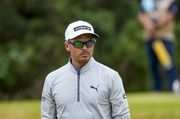
Imago
Keegan Bradley, Ryder Cup Trophy Credit: Imago

Imago
Keegan Bradley, Ryder Cup Trophy Credit: Imago
The 2002 U.S. Open transformed American golf forever. Bethpage Black shattered the sport’s exclusive barriers by becoming the first genuine public course to host the championship. Everyday golfers could finally walk where champions compete. Tiger Woods captured victory at 3-under par as the only player to finish below par in brutal conditions.
Watch What’s Trending Now!
The historic achievement earned the nickname “The People’s Open.” However, hidden behind this democratic triumph lies one of golf’s most perplexing mysteries that has confounded investigators for decades. “WARNING – The Black Course Is An Extremely Difficult Course Which We Recommend Only For Highly Skilled Golfers.” These seventeen words have become golf’s most photographed message. Nevertheless, their origins remain completely unknown despite extensive investigations by journalists, historians, and park officials.
Mike Asheroff provides the most detailed origin story. The former deputy regional director recalls a Memorial Day incident between 1980 and 1982. He was drinking coffee with Superintendent Eric Siebert when trouble erupted on the course. A husband was teaching his wife golf on the Black Course. Their slow pace infuriated a foursome behind them. The situation escalated when both groups started hitting balls at each other.
ADVERTISEMENT
Here’s the story behind Bethpage Black’s infamous “warning” sign. https://t.co/PWTNWkzj7B pic.twitter.com/25PRgHgoB8
— GOLF.com (@GOLF_com) May 16, 2019
“I turned to Eric at that point and said, ‘Give me a piece of paper,’ and I scribbled out the wording of the sign,” Asheroff explained. Park police removed the couple from the course. Within weeks, the warning sign appeared.
However, other credible witnesses challenge this timeline completely.
ADVERTISEMENT
Philip Young, a respected Bethpage historian, insists he saw the sign in 1967. He believes family members discussed it even earlier. Young has logged more than 400 rounds on the Black Course and written multiple books about its history. Despite extensive research efforts, the mystery persists.
Dr. Bill Quirin offers the most adamant early testimony. The Metropolitan Golf Association historian maintains the sign existed by 1969. “It’s perfectly clear to me it was there in ’69, early Seventies. Nobody put that in in [the 1980s],” he stated firmly.
ADVERTISEMENT
Meanwhile, Dave Catalano casts doubt on the early timeline. He directed Bethpage State Park from 1995 to 2011 but started there in 1967. “I’m not gonna get on a stack of bibles and say the sign wasn’t there [before the 1980s], but I don’t recall it,” Catalano noted.
Joe Rehor, the former head professional, categorically states the sign wasn’t present during his college years. He graduated from St. John’s University in 1968 after playing the Black Course since age 13. This creates an impossible timeline where credible sources place the sign’s creation both in the late 1960s and early 1980s.
Even Elizabeth Wintenberger, current park director since 2011, acknowledges defeat. Her team searched relentlessly through old photographs and questioned staff members. “You would have to add me to the list of people who don’t know,” she concluded. A park spokesman confirmed there’s literally no official history on the sign.
ADVERTISEMENT
This transforms the warning into golf’s ultimate mystery. Despite hosting multiple major championships and attracting worldwide attention, nobody can definitively explain when or how this iconic sign appeared.
Top Stories
Amid Brooks Koepka’s Appeal, PGA Tour Reinstates Another Ex-LIV Pro Without Punishment

PGA Tour Pro Rejecting 8-figure LIV Golf Offer Forces Re-Signing of Sacked Golfer

Tiger Woods’s GF Vanessa Trump Wasn’t On Board With Daughter Kai’s New Family Addition

Tiger Woods Comparisons Escalate After Teen’s Record-Breaking Win in America

PGA Tour Makes Feelings Clear as $14 Billion Sponsor Cuts All Ties After 17 Years

Why Bethpage Black’s accessibility paradox defines modern golf
Ironically, the warning sign completely failed its intended purpose. Rather than deterring golfers, it attracts them from around the world. Superintendent Andy Wilson reports that starters photograph visitors with the sign daily. The placard has become more famous than the course itself.
ADVERTISEMENT
The sign’s commercial success proves equally remarkable. FootJoy released a limited-edition all-black golf shoe featuring a warning on the heels. Pro shop merchandise includes shirts, head covers, and replica signs. Course difficulty assessments highlight how Bethpage’s intimidating nature extends beyond the famous sign to every challenging design element throughout the layout.
“The sign went up to discourage people — who were not highly skilled, if you will — from playing the course,” Catalano observed. “I was the director of the park for nearly 20 years, and I never saw a person abide by the sign.”
This creates golf’s ultimate accessibility paradox. A warning meant to exclude became a symbol of public golf’s democratic appeal. Golfers routinely camp overnight in parking lots to secure tee times. The facility hosts nearly 200,000 rounds annually across its five courses. The demand forced new reservation policies including a $5 fee to combat illegal booking programs.
ADVERTISEMENT
The contradiction perfectly captures what makes Bethpage special. It’s brutally honest about difficulty yet welcomes everyone brave enough to attempt the challenge. The mystery surrounding its creation mirrors the democratic spirit it accidentally represents.
Professional golfers have embraced this paradox. Henrik Stenson noted during the 2009 U.S. Open, “I haven’t really played much courses with warning signs. It’s more for the ski slopes, isn’t it?” Geoff Ogilvy added, “I’ve seen lots of rules written down on 1st tees — but I’ve never seen warnings.”
View this post on Instagram
ADVERTISEMENT
Now, the 200,000-plus fans planning to attend the 2025 Ryder Cup face unexpected disappointment. The long-standing placard affixed to the railing behind the first tee has been temporarily removed. This shocking development adds another layer to the sign’s mysterious legacy.
The timing couldn’t be more ironic. Just when the world’s attention turns to Bethpage Black, golf’s most famous warning disappears. Perhaps this temporary absence will only deepen the mystique surrounding its unknown origins. Perhaps that’s perfectly fitting for golf’s greatest unsolved mystery. A sign meant to warn golfers away instead draws them in. Its mysterious past creates its own mystique as enduring and impenetrable as the course it guards.
Do you think this decades-long investigation will ever reveal the truth? Share your thoughts about golf’s most famous unsolved puzzle.
ADVERTISEMENT
ADVERTISEMENT
ADVERTISEMENT
ADVERTISEMENT

